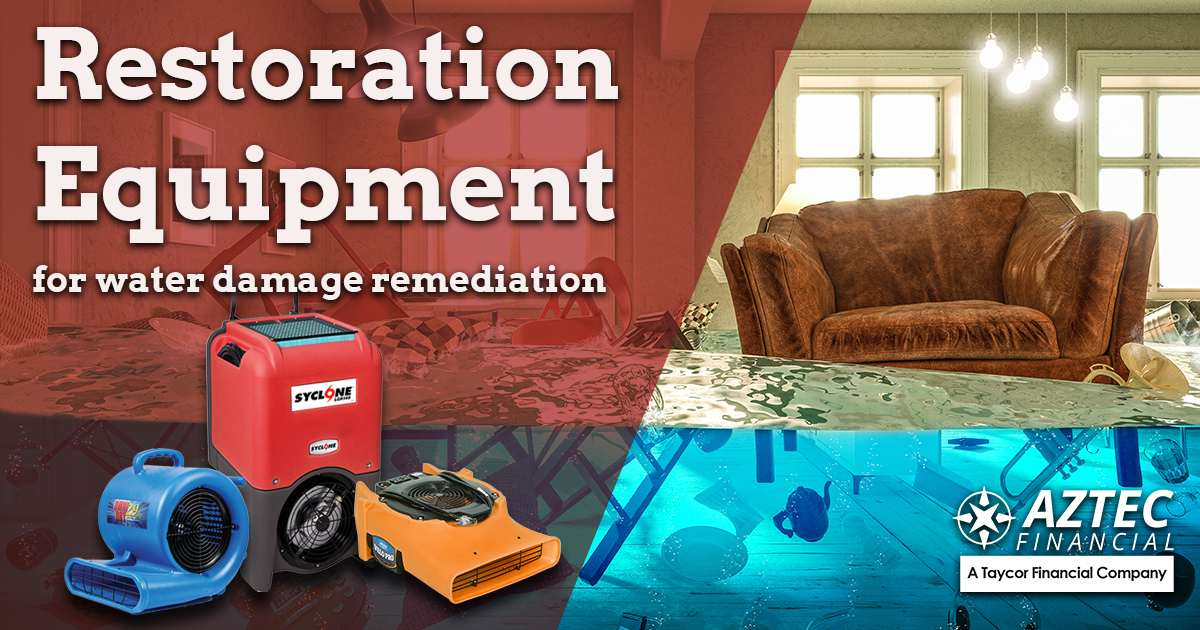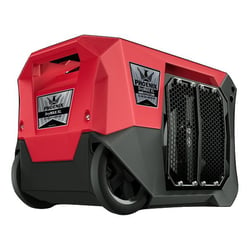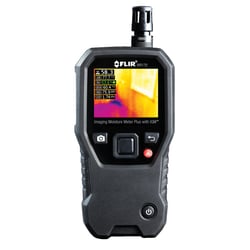This post originally appeared on Aztec financial's blog and has been cross-posted with permission.
Every restoration company faces a similar challenge as hurricane season sets in, preparing cash flow for an unpredictable storm season. No one knows how big the storm season will be, or when and where it will hit first. Insurance claim size and the backlog on receiving payment can vary dramatically.
Preparation is key for modern-day restoration heroes, and since the Atlantic hurricane season is just around the corner, the time to get prepared is now. When it comes to overcoming cashflow challenges, having the right equipment is crucial to successfully help impacted customers. Therefore, two major questions arise to overcome this challenge: What equipment will be needed and how do I pay for it?
Let’s take a closer look.
What To Know
Generally, hurricane seasons are unpredictable but weather patterns and damages each storm causes are mostly the same. That makes preparation easier for everyday people who are directly affected by hurricanes and for those in the restoration business.
Officially, hurricane season is from June to November, and peaks between mid-August through mid-October. This peak is due to the ideal conditions of wind factors and temperature, and moisture in the Atlantic basin which encourages cyclonic activity. Accordingly, the area from Texas through Florida to New York is mostly affected in the U.S. by hurricane season.

The Saffir-Simpson Hurricane Wind Scale
It is also helpful to know what damage each storm can cause since it gives you a brief idea of what to expect. The Saffir-Simpson Hurricane Wind Scale provides a good overview:
Category 1: Dangerous (74 to 95 MPH)
Dangerous winds that cause some damage to not well-constructed frame buildings. Large branches of trees will snap, and shallowly rooted trees may be toppled.
Category 2: Very Dangerous (96 to 110 MPH)
Well-constructed frame homes could sustain major roof and siding damage. A high risk of trees blocking roads and near-total power loss is expected with outages that could last some days.
Category 3: Devastating (111 to 129 MPH)
Ruinous damage will occur where electricity and water will be unavailable for several days to weeks.
Category 4: Catastrophic (130 to 156 MPH)
Well-built framed homes may lose most of the roof structure or some exterior walls. Most of the trees will be uprooted, electricity is down. Most of the area will be uninhabitable for weeks or months
Category 5: Totally Catastrophic (157 MPH and over)
Very high potential of houses with total roof and wall collapse. Fallen trees and power poles will isolate residential areas and will be uninhabitable for weeks or months.
Common Types of Hurricane Damage
Water Damage:
Floodwaters are considered a very destructive and dangerous aspect of a hurricane and can affect any part of a building. Therefore, the most common repair work is water damage restoration and repair. Floodwaters can carry toxins, contaminants, bacteria, and other substances that are harmful to humans and animals. The longer the water stays in a building the worse the damage becomes. That’s why restoration companies must act immediately to remove the water and dry out both visible and hidden areas. Failure to do so in a timely manner increases the risk to the homeowner and can result in mold and mildew growth.
Roofing, Windows, and Doors
High winds, flying debris, and large amounts of water can cause significant roof and entrance damage. Although the storm itself may have passed, weather conditions may still be bad. Identifying damage to roofs, windows, and doors, especially in rainy and windy conditions, can help prevent additional weather damage to the interior of the structure.
Equipment That Makes a Difference
Removing the water is the foundation on which reconstruction work can begin. Unfortunately, it can take days or even weeks for flooding water to subside. With knowledge of specific techniques and the right equipment, restoration companies are the needed experts to remove the water. Since there are many types of equipment, we want to give you a brief overview of some basic equipment every restoration business should have and that will make the following work much easier.
Portable Water Extraction:
Removing standing water is a high priority in a flood scenario. During flood remediation, portable water extraction systems are often used to remove excess water. These systems pull the water out of the affected area, leaving it easier to dry and stopping additional moisture from spreading.
Dehumidifiers:
As the name suggests, dehumidifiers remove moisture from the air. This improves drying times, particularly in humid environments where surfaces typically take longer to dry out. Depending on the size of the dehumidifier, it can remove anywhere from 80 to 130 pints of moisture per day. If you want to remove moisture more effectively, an LGR (Low Grain Refrigerant) Dehumidifier is a great update for your equipment. It differs from a standard dehumidifier, in pre-cooling the intake air, resulting in more and better water removal and drier processed air. That makes it indispensable for any professional restoration business.
Air Movers:
Air movers are industrial strength fans that are designed to circulate air in affected areas. They are used to dry carpets, drywall, and other material surfaces. Since they’re available in a variety of shapes and sizes, they fit any area of a home and are easy to transport. For best results, multiple air movers are set up throughout the home or business, increasing air circulation and improving drying times.
Air Scrubbers:
With these handy and helpful machines, removing unwanted particles from the air becomes easy. These could be containments, gases, fungal spores, dust particles, bacteria, and more. Removing them will give the air an instant refresh, making it cleaner and removing unwanted smells.
Moisture Meters
Moisture meters are a vital tool for any restoration company working on an insurance job. They measure the amount of moisture in structures, including behind enclosed spaces like walls and subfloors. Many insurance companies require moisture readings before and after a restoration job, so taking accurate measurements throughout the process is key.

Buying Your Equipment
Whether you’re about to start your business or you want to update your existing equipment, the question of “How do I pay for it?” comes up. Equipment financing is a great way to get what you need without having to use your savings. Aztec Financial has created multiple finance products that are designed to meet your business needs. Our dedicated Account Managers will help you find the program that is best suited for your business, whether that is a simple equipment loan, or a business line of credit that can be used for equipment, payroll, or whatever else you may need. Apply for financing at www.aztec.credit or call 855-252-7233 to get started.
Interested in more hurricane season-related topics? Here are some great articles to check out:
- Responding to Natural Disasters https://aztecfinancial.com/responding-to-natural-disasters/
- The Disaster Restoration Equipment You Need Before Hurricane Season https://aztecfinancial.com/the-disaster-restoration-equipment-you-need-before-hurricane-season/
Featured Products
 Phoenix, Dehumidifier, Dry Max LGR, With Bluetooth, Red
Phoenix, Dehumidifier, Dry Max LGR, With Bluetooth, Red

Syclone, Airmover, Low Profile, 1.9 Amp, Blue

Syclone, Sentry X4 HEPA Air Scrubber, Blue

FLIR, Moisture Meter, FLIR MR176
